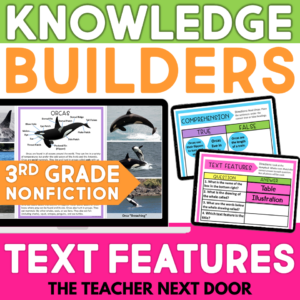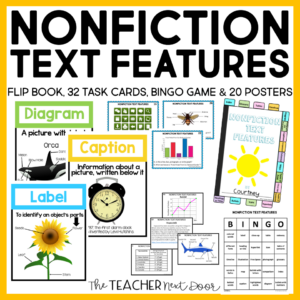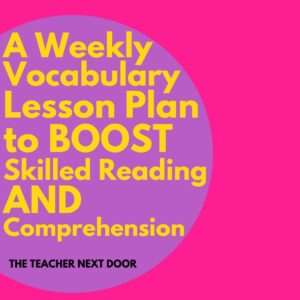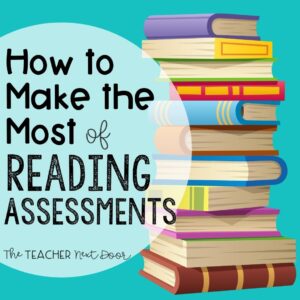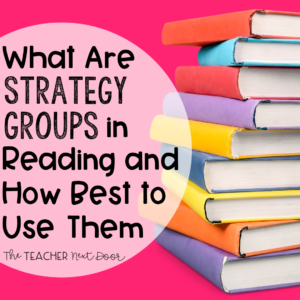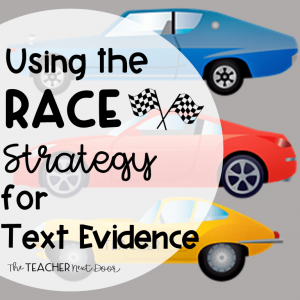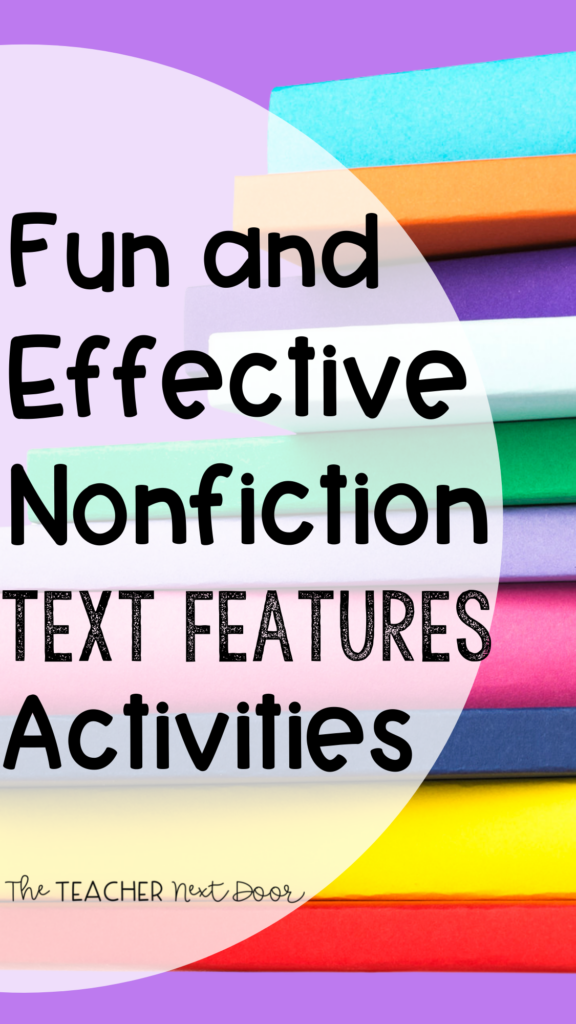
“Nonfiction Text Features” at first glance may may not sound super exciting, but it’s such a fun reading concept to teach! It’s not a phrase that typically gets kids jumping out of their chairs with excitement.
Of course, not everything at school is going to be fun and exciting, but I have found that the more fun you and your students have with a lesson, the more excited they will be. And let’s face it…excited = engaged!
Rather than covering everything with glitter, dressing up in a crazy costume, or baking special cookies shaped like the lesson topic…it’s good to find more authentic ways to engage students in their learning. Is this harder? Yes! But helping students build true excitement about the actual topic, rather than a bunch of hoopla that doesn’t really have anything to do with it, is often how you put students on the path of becoming lifelong learners.
Today I’m going to share some fun activities that you and your students can do with nonfiction text features. Hopefully in the process, they will see how awesome and useful these text features are!
What Are Nonfiction Text Features?
Before I go any further, let’s quickly review what “text features” are and why they are important. (You probably know, but just in case!)
First, you have headings, subtitles, and bold, underlined, or italicized words and phrases. Students probably won’t skip over these, since they’re part of the main text. However, we still need to make a point to teach students how these features can be helpful.
Other text features are on the main page but are still separate from the text itself. These are things like sidebars, pictures and captions, and labeled diagrams.
I’m always amazed how so many kiddos, even my very highest readers, are so quick to ignore these! It seems they have just one goal, to get to the end of the text, and anything “extra” just doesn’t get their attention.
Of course, you and I know how these text features provide a wealth of information and often include details that aren’t found in the main text at all. It’s super important to get students to see these as a vital part of the text and take the time to carefully read and study them.
The last kind of text feature might be the most important to teach students about because they are separate from the main body of the text. Think table of contents, index, glossary. It’s very easy for students to ignore these entirely since they come before or after the main text.
Since these are such powerful tools, we must explicitly teach students what these text features have to offer and how to use them.
Now that we’re all on the same page with why we need to teach them, let’s get to the good stuff! How can you teach text features in a way that is both fun and effective for students? Keep reading for some of my best ideas!
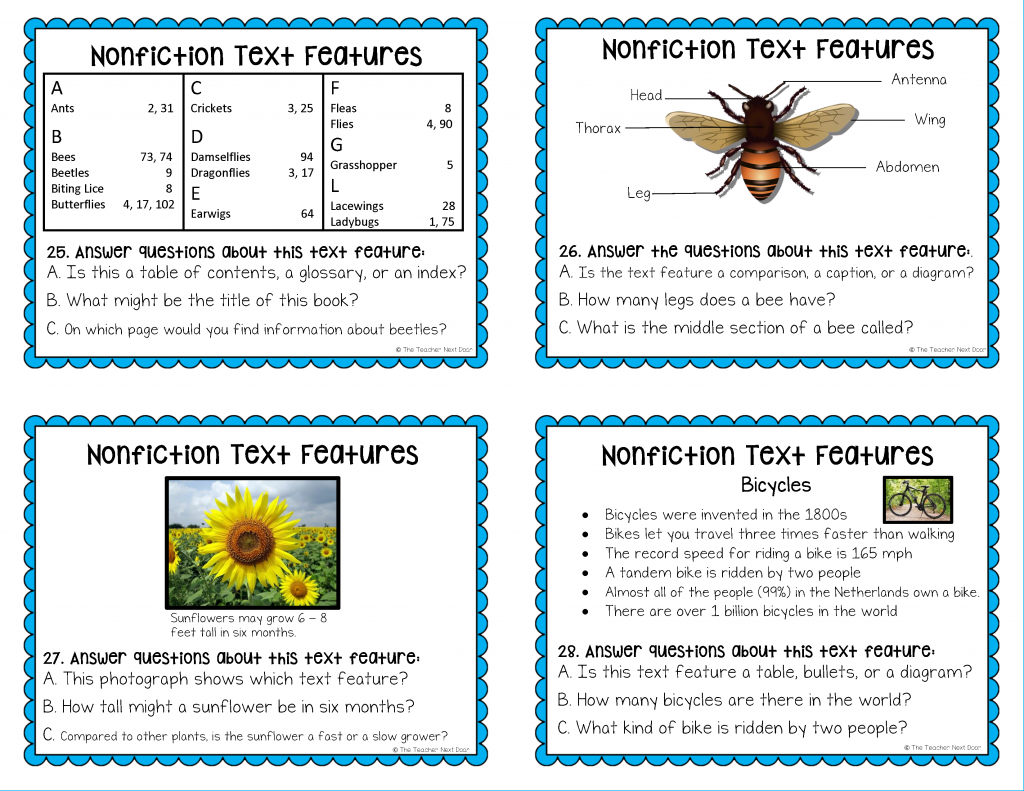
Nonfiction Text Features Task Cards
Anchor Charts
Like with anything else you’re studying, it’s a great idea to make anchor charts about text features. You can pre-make these, have students help you create them as a class, or even assign groups of students to make charts about specific text features and share them with the class. No matter which way you choose, it will be super helpful for your students to have a visual reference when learning about text features.
Color Coding
Who doesn’t love a good color-coding session?! This activity is perfect for when you are just beginning to study text features. Provide students with a text, and make sure that it includes clear examples of each text feature. Then, assign a specific color to each different type of text feature and have students mark each one with the coordinating color.
This is the perfect way to get students to recognize and find these text features. They could do this in small groups, or work on their own and then compare with a partner after a set amount of time.
(Sneaky) Scavenger Hunt
Not your average scavenger hunt, I challenge you to get sneaky! Include mostly things that are only found in the text features, not in the main body of the text.
One fun thing to do if you create your own passage is to add your own silly tidbits or details to the captions, charts, glossary, etc., and ask questions about what you added. That way students can only answer if they carefully check out the text features.
Another idea you can use with any nonfiction text is to ask students to specifically look at certain things, like a caption for example. You can ask something like, “What is the third word in the second sentence of the caption on pg. 4?” You can also ask specific questions about details in the pictures, charts, etc.
The purpose here is less about getting students to understand the content at this point and more about making sure that they are exploring all the text features thoroughly.
You might do a sneaky scavenger hunt a few times at the beginning of your study. Once students are tuned in to carefully reading the text features, you would want to switch to asking content-related questions.
DIY (Students, that is!)
Give students a text to work with, and ask them to create their own text features. You may want to start with everyone doing the same one, such as a caption for a specific picture. Look at several examples, brainstorm what makes a good caption, and write one as a class. Then move on to a different type of text feature.
Once students are familiar with the different features, assign kids different types of text features to go along with them.
Friendly Competition
It’s one thing for students to see the text features in their textbooks and teacher-provided articles, but we also want them to utilize these text features when reading other nonfiction texts.
One fun way to get students to recognize and utilize these features is by having a friendly competition. You could call it “Nonfiction Text Features: They Do Exist,” or “Text Features in the Wild,” or something similar.
When students are reading authentic texts and come across one of these text features, have them snap a quick picture or make a note of the book and page number.
Create a bulletin board to display all the examples that your students find, or have them create a digital presentation with all their examples.
You might even give a point for each one, or have a class goal of a certain number to find. Whatever works for you! No matter how you decide to execute it, this is a SUPER fun and effective way to get students to find these text features in the “real books” they are reading.
Resources
If you’re looking for a no prep way to practice with text features, look no further! I’ve got an awesome Text Features Digital Reading Unit for 3rd grade that has everything you need to teach text features.
It includes two sets of high-interest reading passages, two vocabulary activities, two comprehension slides, and four slides that focus on using text features with nonfiction text. These activities are perfect for independent work, literacy centers, homework, test prep, and more!
Want even more high-interest text and activities to use when working on nonfiction text features? Check out this Nonfiction Text Features Activities set. This resource is packed with fun activities to help your students master text features in informational text. It includes a flipbook, 32 task cards, a Bingo game, and 21 posters, plus detailed teacher notes for the busy teacher!
You might also like this post:
Teaching Nonfiction Text Features
Thanks so much for stopping by!


